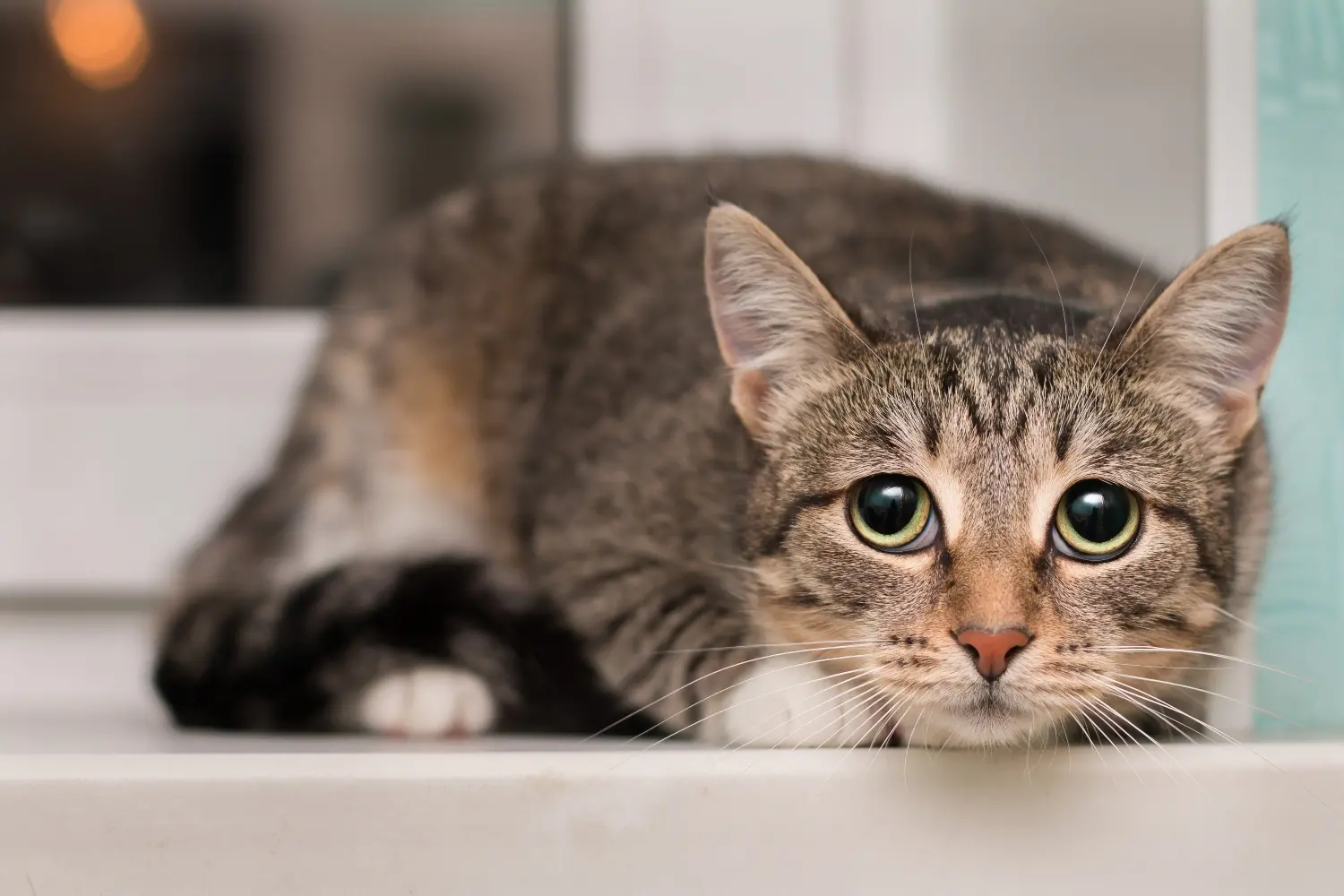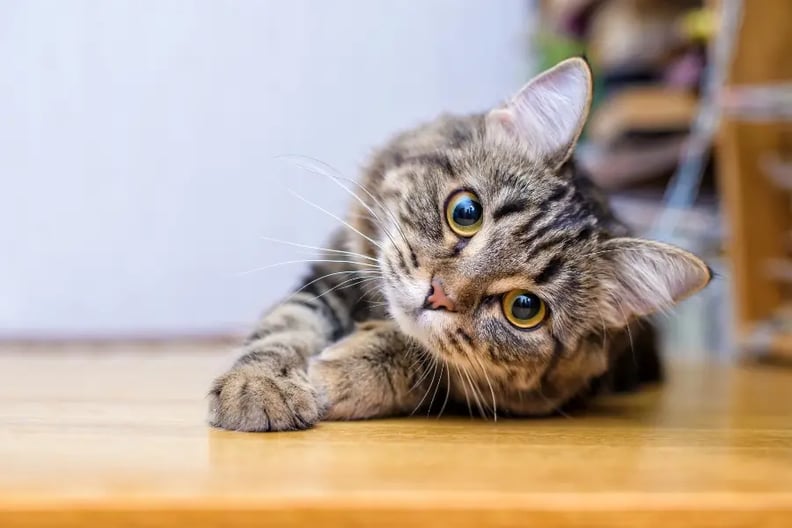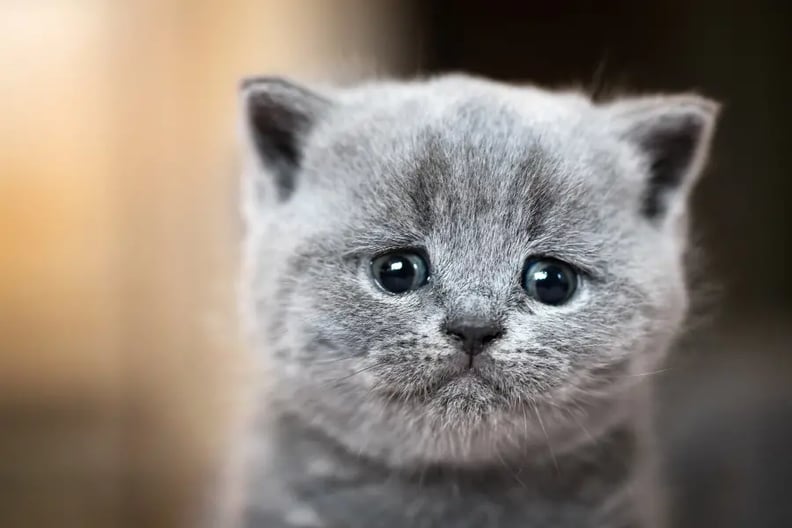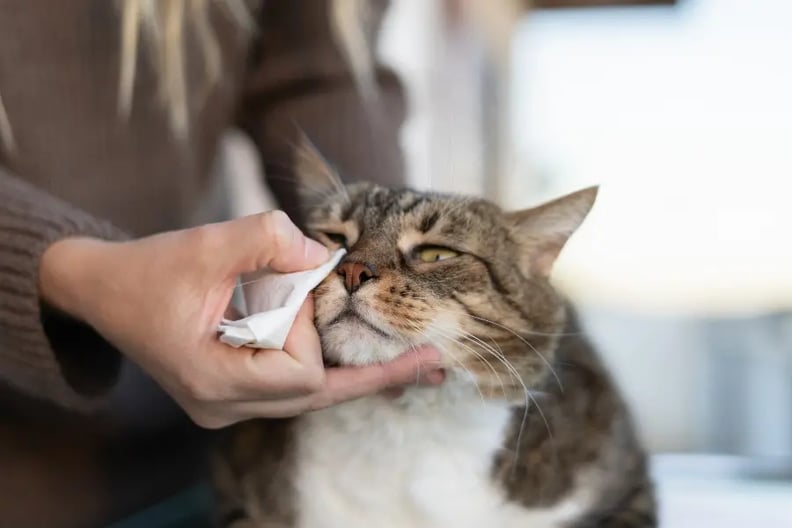
Have you ever wondered what the world looks like through a cat's eyes? Learn more about your cat's vision and get answers to common questions like - How do cats see and do cats see colour?
Cats are fascinating creatures, known for their keen senses and mysterious behaviours. Among their senses, vision plays a crucial role in how they navigate the world around them.
Their eyes can also tell a story. When your cat is hunting, their eyes might get big and round, but when they are silently judging us from across the room, their eyes will get narrow and squinty. These cat body language queues can help learn to interact better with your cat.
Knowing what and how your cat sees can help you provide them with a safe and stimulating environment. This will reduce boredom and anxiety, and help your cat live a happy, healthy, and long life.
Read on to learn some cool facts about your cat's eyesight and get some tips for helping to keep their vision healthy for as long as possible.
Cat Vision Explained
To comprehend how cats see, we must first understand the anatomy of their eyes. Like humans, cats have binocular vision, meaning their eyes work together to perceive depth and distance. However, there are notable differences in their visual capabilities compared to humans.
Visual Acuity
You might be surprised to know that your cat's vision is not as sharp as yours, meaning what they see is a little more blurry. But what they lack in general visual acuity, they may up for with the ability to detect motion and see better with very little light.
This is attributed to their large pupils, which can dilate widely to allow more light to enter the eye, and a high concentration of rod cells in their retinas, specialized for low-light vision.
Colour Perception
Contrary to popular belief, cats are not colorblind. However, their colour vision is not as vibrant as that of humans. Cats have fewer cones in their retinas, which are responsible for perceiving colour.
Because of this, cats see blues and yellows better, while reds and greens are more difficult for them to distinguish. Understanding how cats perceive colour is helpful in providing a stimulating environment for cats.
Cat toys, especially those meant for chasing and hunting, are likely going to offer more excitement and stimulation if they fall in the colour spectrum that cats see well. Here are a few of our favourite cat toys offered in cat-friendly colours:
Field of View
Cats have a wider peripheral vision than humans, encompassing approximately 200 degrees compared to our 180 degrees. This wide field of view allows them to detect movement from various directions, an adaptation useful for hunting prey and detecting potential threats.
Depth Perception
Depth perception is essential for judging distances accurately. Like humans, cats have binocular vision, which allows them to be able to judge distances well. This is a significant factor in their agility and hunting skills.
What Makes Cat Eyes Unique from Humans?

Cat eyes have some pretty unique physical characteristics. Some of them are easy to spot, like the shape of their pupils, but many of the cool features of cat eyes happen behind the scenes. Take a look at some of the interesting anatomical traits that make cat's eyes work uniquely from humans:
Cats Have Three Eyelids
To further protect their sensitive eyes, cats have a third, inner eyelid called the nictitating membrane that is located in the inside corner of your cat's eye, below the two normal eyelids. This whitish fleshy-looking layer extends up to provide a lubricated covering for the eye.
When your cat's eyes are open, the third lid is typically not visible in most cat breeds, as it should fully retract. The only time you are likely to see it is if your cat is sleeping with their regular lids slightly ajar or if the protective membrane is inflamed or irritated.
Cat Pupils Are Highly Reactive
Unlike humans, whose pupils remain round in various lighting conditions, cat pupils undergo remarkable transformations, adjusting in size and shape to optimize vision in different environments.
In bright light, a cat's pupils constrict into narrow vertical slits, resembling thin slivers. This slit shape helps reduce the amount of light entering the eye, protecting sensitive retinas from potential damage while maintaining clarity of vision.
In dim lighting or darkness, however, cat pupils dilate to their maximum extent, expanding into large, round pools. This dilation enables cats to capture as much available light as possible, enhancing their ability to see in low-light conditions.
This dilation gives your cat the "Puss in Boots" look and you will probably see this cool skill when your cat is hunting. By maximizing light intake, cats can effectively hunt, navigate their surroundings, and help them quickly react to movement.
Cats Have Low Light Reflectors Behind Their Retina
Just like humans, cats have retinas at the back of the eye that contain rods and cones to process light and colour respectively. Cats not only have more rods than humans, (fewer cones), but they also have an extra membrane behind the retina to enhance light sensitivity.
A reflective membrane called the Tapetum Lucidum helps to reflect light to the rods in your cat's eyes allowing them to see better in very low light conditions effectively.
They can't see in complete darkness, but they can see better than humans in very low light. Even just the light of the moon coming in from a window could be enough to allow your cat to safely navigate through your home, find their litter box, and even play at night.
Frequently Asked Questions About Cat Vision

Can Cats See in the Dark?
This is a common belief, but the truth is that cats can't see in total darkness, but they do see a lot better than we do in low and even minimal light. This makes them adept hunters, even at night.
Why Do Cat Eyes Glow in the Dark?
The same feature that helps them see better in the dark also gives their eyes the appearance of glowing. The reflector behind their retinas reflects the light that enters the eye, giving it the appearance of glowing.
Can Cats See Colour?
Much like dogs, cats were previously thought to be colourblind, but it's now thought that cats can see a limited range of colours. Blues and yellows are seen best while red and green are more likely seen somewhere on the greyscale.
Why Do My Cat's Eyes Dilate?
Your cat's ability to rapidly dilate their pupils helps them to take in more light and helps them track movement better. You'll often see your cat's pupils dilate when they are playing or hunting. This indicates that they are at maximum alertness and ready to pounce.
Do Cats See Better Than Humans?
Yes and no. Cats don't see the same range or vibrancy of colour as humans nor do they have the same visual acuity, but because of the shape and movement of the eye, cats can allow in more or less light and have a wider field of view allowing them to see movement better and see better in low light, making them exceptional hunters.
Common Cat Vision Problems
While cats possess remarkable visual abilities, they are also susceptible to various vision issues that can impact their quality of life. Many cat eye problems are most common in senior cats, but depending on lifestyle, health, and genetics, cats of any age can suffer from vision problems.
Here are a few of the more common vision problems in cats:
Cataracts
One common condition affecting cats is cataracts, which occurs when the lens of the eye becomes clouded, leading to blurred vision or blindness. Cataracts can develop due to aging, genetic predisposition, or underlying health conditions such as diabetes.
While cataracts can be surgically removed in some cases, early detection and intervention are crucial to prevent further deterioration of vision.
Glaucoma
Another prevalent vision issue in cats is glaucoma, characterized by increased pressure within the eye, resulting in damage to the optic nerve and loss of vision. Glaucoma can be primary, occurring independently, or secondary, resulting from underlying conditions such as inflammation or trauma.
Symptoms of glaucoma in cats may include redness, cloudiness, or bulging of the eye, as well as behavioural changes such as lethargy or decreased appetite. Prompt veterinary evaluation and treatment are essential to alleviate discomfort and preserve the remaining vision.
Injury & Infections
In addition to these genetic and age-related conditions, cats may also experience vision issues as a result of trauma or injury to the eye. Corneal ulcers, for example, can occur due to scratches or foreign objects entering the eye, leading to pain, redness, and impaired vision.
Prompt veterinary care is essential to prevent complications such as infection and corneal scarring, which can further compromise vision. Treatment may include topical medications, protective eyewear, or surgical intervention, depending on the severity of the injury.
How To Help Support Good Eye Health in Cats

Vision, like every other process in your cat's body, is largely supported by their overall health. Healthy cats are less likely to develop age-related diseases and will have a stronger immune system to fight off infections and viruses.
Eye issues in cats are often not diagnosed until they are well advanced, so regular veterinary check-ups and proactive management of underlying health conditions are crucial for maintaining optimal eye health and vision in cats.
Additionally, there are some things you can do to help keep your cat healthy, especially as they age:
Good Food for Healthy Eyes
The foundation of a healthy cat is a complete, balanced, and nutritious feline diet. Choosing an appropriate food made from high-quality and real food ingredients is a great place to start. When your cat regularly consumes natural and premium nutrients that their bodies are designed to eat, you will give them a better chance of staying healthy for longer.
Cats also thrive on a moisture-rich diet. Moisture helps to digest and distribute nutrients throughout the body. Cats also get most of their moisture from their food, so incorporating wet or fresh food into their diet can have a positive overall impact on their health.
Keep Your Cat's Eyes Clean
Most cats are independent groomers, and do a pretty good job of keeping themselves mostly clean, but regularly grooming your cat is still important even for the most dedicated groomers.
Regular brushing, spot cleaning, nail trimming, and face cleaning can help to prevent injury and infection. Cats who get tear stains, like Persians, will need more regular grooming, while other cats may just need to be spot-cleaned as needed.
Safe Environments
Your cat's environment can also have an impact on their eye health. Cleanliness is important, and that includes things like regularly cleaning their beds, washing their food bowls, replacing dirty or damaged toys, and keeping a well-maintained litter area.
Consider all the things in their environment that could lead to injury or illness. Things like air quality are important too. Don't smoke around your cat, and avoid using cleaning sprays, hairspray, and spray air fresheners that contain chemicals.
Lysine for Eye Health
While a complete diet will contain the full spectrum of amino acids that your cat needs, Lysine supplements can be a helpful tool for cats that are prone to eye issues. A Lysine supplement, like Naturvet L-Lysine Soft Chews, can help to provide additional vision support by reducing inflammation in the eye and boosting overall immune system health.
The Importance of Proper Eye Care for Cats
Your cat's eyes are powerful and intricate, and a key factor in their hunting abilities and natural agility. From their slit-like pupils and exceptional night vision to their keen depth perception and innate hunting instincts, every aspect of feline vision reflects their predatory lifestyle.
Understanding how cats see not only deepens our appreciation for their sensory capabilities but also enhances our ability to provide them with healthy, safe, and stimulating lives.
Your cat's eye health is important and it's essential to keep their eyes healthy, especially as they age. Regular check-ups, early detection of vision issues, and prompt treatment are essential in maintaining optimal eye function and preventing unnecessary suffering.
Beyond their practical function, cat eyes serve as windows into their emotions and mental state. Whether dilated in excitement or narrowed in contentment, a cat's eyes can indicate their mood and intentions. Understanding what their eyes tell you, as well as their overall body language can help you build a stronger bond with your feline friend.
.png?width=200&height=66&name=logo%20(1).png)




.jpg)
